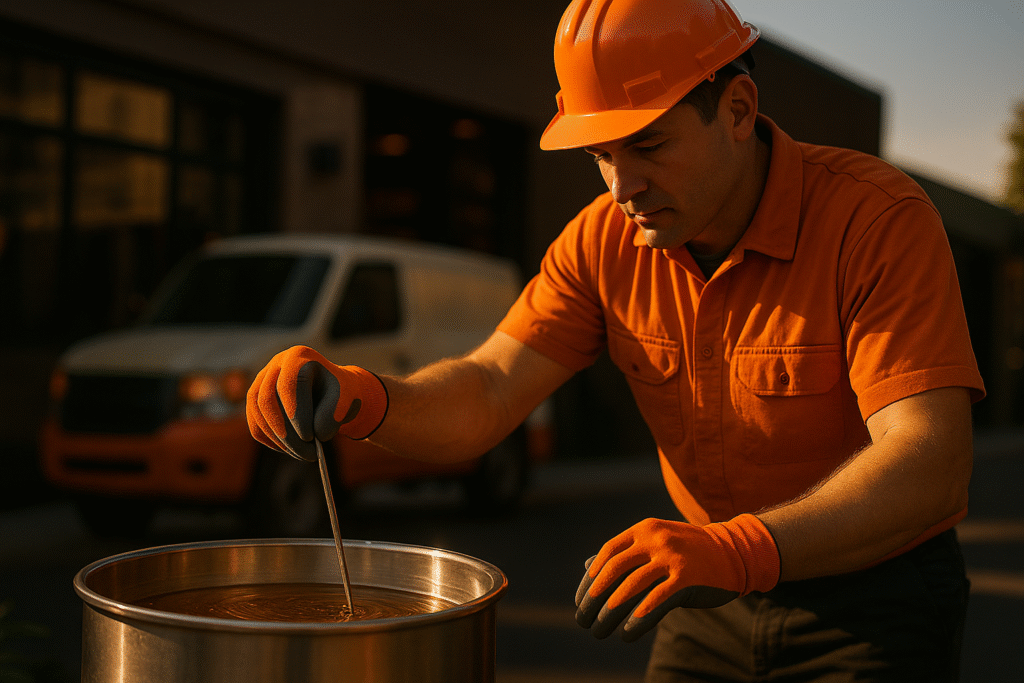Jump to a question:
- How to get rid of a large amount of grease?
- What is the best way to dispose of old cooking grease?
- How can I get rid of old grease?
- How do you dispose of fat and grease?
- Can you sell grease for money?
- How much can I get for used cooking oil?
- How much do grease collectors make?
- What do grease trap companies do with the grease?
How to get rid of a large amount of grease?
Partner with a licensed cooking oil collection company that provides scheduled grease pickup and proper containers—most offer free service for restaurants producing over 100 gallons monthly.
Large-scale restaurant grease disposal requires professional waste management solutions. Companies like Grand Natural Inc., Grease Connections, and Baker Commodities operate as cooking oil recycling companies specializing in handling significant volumes of used cooking oil and vegetable oil from commercial kitchens across the United States. These services provide everything from initial container delivery to regular grease pickup schedules tailored to your specific recycling needs.
The process starts with a simple phone call or tap of a button through proprietary applications. Cooking oil recycling service providers assess your oil production volume, typically measured by how many fryers you operate and how often you change them weekly. Based on this assessment, they’ll place appropriately sized cooking oil equipment—ranging from 100 to 300-gallon units—in convenient space near your kitchen for easy access during grease pickup.
Professional grease collection companies ensure compliance with local regulations through proper documentation. They provide waste transfer manifests essential for city inspections, proving your restaurant follows environmental responsibility standards. This documentation protects your business from severe penalties including fines up to $10,000 or forced closure.
⚠️ Never attempt DIY disposal methods:
- Pouring into drains creates solid residue that restricts water flow
- Dumping in dumpsters violates waste management regulations
- Disposing into natural water bodies causes disastrous environmental impacts
Summary: Large grease volumes require licensed collection services that provide containers, scheduled pickups, and compliance documentation—most offer free service for high-volume producers.
What is the best way to dispose of old cooking grease?
The best disposal method is recycling through licensed cooking oil recycling companies that convert waste oil and vegetable oil into biodiesel, preventing plumbing damage while ensuring regulatory compliance.
Professional fryer oil recycling services represent the gold standard for restaurant grease disposal in the food industry. Companies like Mahoney Environmental operate as full-service cooking oil recycling service providers ensuring reliability throughout the disposal process, from collection to final recycling. This approach transforms potential restaurant grease waste into valuable resources while protecting your plumbing systems and the environment.
The recycling process begins when trained technicians safely collect used oil from your designated containers. They transport it to processing facilities where it’s refined into biodiesel fuel, animal feed supplements, or industrial lubricants. This circular economy approach delivers positive impact by reducing landfill waste and creating sustainable alternatives to petroleum products.
Cost-effective solutions make professional recycling accessible for all restaurant sizes. Many companies provide rebates for businesses producing significant amounts monthly—typically starting at 100 gallons. Grand Natural offers free used cooking oil collection service when minimum quantities are met, making proper disposal financially beneficial rather than burdensome.
Regular collection schedules prevent the health hazards associated with improper storage. Weekly or monthly pickups ensure fresh operations while eliminating risks of rancid oil attracting pests or creating slip hazards. Professional services handle everything from pumping to cleaning, allowing your staff to focus on food preparation rather than waste management.
💡 Pro Tip: Schedule pickups based on your oil usage patterns—busy restaurants may need weekly service while smaller establishments manage with monthly collections.
Summary: Professional recycling through licensed companies offers the safest, most environmentally responsible disposal method while providing financial benefits through rebate programs.
How can I get rid of old grease?
Contact a grease collection company for immediate pickup service—they’ll pump out old grease, clean your containers, and establish ongoing collection schedules to prevent future buildup.
Getting rid of accumulated grease requires expert teams equipped with specialized pumping equipment. JR Grease Services offers both scheduled and on-demand collection catered to immediate needs. Their technicians arrive with vacuum trucks capable of handling everything from small grease traps to large interceptor cleanouts.
The removal process is surprisingly efficient. Service providers can typically respond within 24-48 hours for urgent situations. They’ll assess your current grease storage, pump out all accumulated waste, and thoroughly clean containers to eliminate odors. This comprehensive approach ensures your kitchen returns to peak efficiency quickly.
For restaurants dealing with inherited restaurant grease problems—perhaps from previous tenants or neglected maintenance—collection companies provide one-time cleanup services. They’ll remove old, hardened grease deposits, replace damaged cooking oil equipment if needed, and implement proper management systems to prevent future issues.
Prevention strategies accompany removal services. Professional companies educate staff on proper grease handling, helping establish best practices that reduce accumulation. They’ll recommend appropriate container sizes, optimal placement for convenient access, and maintenance schedules aligned with your production volume.
Summary: Professional grease collectors such as Grease Connections provide immediate removal services, clean existing systems, and establish preventive maintenance programs to eliminate future buildup problems.
How do you dispose of fat and grease?
Dispose of fats and grease by cooling them in designated containers, then arranging pickup through commercial waste oil recycling services—never pour down drains or into regular trash.
Proper fat and grease disposal starts in your kitchen with designated collection points. Used cooking oil should cool to safe handling temperatures before transfer to storage containers. Professional services provide specialized bins designed to handle both liquid oils and solidified fats from fryers, grills, and other cooking equipment.
The cooling process is critical for safety. Hot oil poses burn risks and can damage standard containers. Allow oils to drop below 120°F before handling. Solid fats from grills and griddles can be scraped directly into collection bins once cooled. This systematic approach prevents workplace accidents while ensuring efficient collection.
Storage between grease pickups requires proper containers placed in accessible space. Indoor storage areas should have adequate ventilation and spill containment for restaurant grease management. Outdoor containers need secure lids to prevent rainwater contamination and unauthorized access. Many restaurants position cooking oil equipment near back doors or loading docks for convenient service access during scheduled grease pickup.
Regular grease trap cleaning complements proper disposal practices. While containers handle bulk cooking oils, grease traps capture residual fats from dishwashing and food prep. Coordinating both services through a single provider simplifies waste management while ensuring comprehensive compliance with regulations.
⚠️ Critical violations to avoid:
- Mixing grease with regular garbage
- Using storm drains for disposal
- Storing in unauthorized containers
- Allowing grease to enter septic systems
Summary: Cool fats and grease in designated containers for professional pickup—coordinated disposal services prevent drain blockages and ensure regulatory compliance.
Can you sell grease for money?
Yes, restaurants can earn rebates ranging from $0.10 to $0.65 per gallon for used cooking oil, with many collection companies offering payment programs for consistent producers.
The used oil market has transformed restaurant grease waste into a revenue stream. Oil collection companies compete for reliable sources to meet growing biodiesel demand and recycling needs. This competition benefits restaurants through rebate programs that offset restaurant grease disposal costs or generate modest profits.
Rebate structures vary by company and market conditions. Factors affecting payment include oil quality, volume consistency, and local market rates. Restaurants producing over 200 gallons monthly often qualify for premium rebates. Some providers offer tiered programs where higher volumes earn better per-gallon rates.
Payment methods accommodate different business preferences. Options include monthly checks, account credits, or donations to designated charities. Baker Commodities customizes payment plans to meet unique business needs, whether you prefer cash rebates or service credits against other waste management fees.
Quality matters for maximizing rebates. Clean oil free from water, food particles, or other contaminants commands higher prices. Proper storage and handling—keeping containers covered, avoiding mixing with water, filtering out debris—directly impacts rebate amounts. Training staff on quality maintenance pays dividends.
📊 Typical rebate ranges by volume:
- Under 100 gallons/month: Free pickup, no rebate
- 100-300 gallons/month: $0.10-$0.25/gallon
- Over 300 gallons/month: $0.25-$0.65/gallon
Summary: Used cooking oil generates revenue through rebate programs, with payments ranging from $0.10-$0.65 per gallon based on volume and quality.
How much can I get for used cooking oil?

Current market rates for used cooking oil range from $0.25 to $0.65 per gallon, with prices fluctuating based on biodiesel demand, oil quality, and your monthly volume.
Market dynamics determine used cooking oil values. Biodiesel demand drives pricing, with rates typically higher during summer driving season and lower in winter. Geographic location also impacts rates—areas near biodiesel refineries often see better prices due to reduced transportation costs.
Volume commitments unlock better rates. Restaurants consistently producing 300+ gallons monthly can negotiate premium pricing. Some recycling companies offer contracts guaranteeing minimum rates regardless of market fluctuations, providing predictable revenue streams for budget planning.
Oil quality significantly affects pricing. Yellow grease (clean fryer oil) commands top dollar, while brown grease (trap grease) receives lower rates. Maintaining oil quality through proper filtration and storage maximizes value. Avoiding contamination with water or cleaning chemicals preserves premium pricing eligibility.
Collection companies handle all logistics, making the process seamless. They provide containers, schedule pickups, pump oil, and process payments—eliminating any operational burden on restaurant staff. This turnkey service transforms waste disposal from a cost center into a profit contributor.
💰 Value optimization tips:
- Filter oil daily to remove food particles
- Keep containers covered to prevent water contamination
- Don’t mix different oil types
- Schedule pickups before oil degrades
Summary: Used cooking oil values range from $0.25-$0.65 per gallon, with consistent volume and quality maintenance maximizing revenue potential.
How much do grease collectors make?

Professional grease collectors earn between $35,000-$65,000 annually, with owner-operators of collection businesses potentially earning $100,000-$250,000 depending on route density and processing capabilities.
Individual collectors working for established companies typically start at $15-$20 hourly, with experienced drivers earning $25-$30 plus benefits. The job combines truck driving, customer service, and basic equipment maintenance. Many companies offer performance bonuses based on route efficiency and customer satisfaction.
Owner-operators see higher earning potential by cutting out middlemen. A single truck operation servicing 50-100 restaurants can generate $10,000-$20,000 monthly in gross revenue. After expenses including truck payments, fuel, insurance, and processing fees, net earnings often reach $5,000-$10,000 monthly.
The business model scales efficiently. Adding trucks and routes multiplies revenue while overhead grows more slowly. Successful operations often expand into related services like grease trap cleaning and interceptor maintenance, creating multiple revenue streams from existing customers.
Market conditions favor growth. Increasing biodiesel demand and stricter environmental regulations expand the customer base. Restaurants need reliable partners for regulatory compliance, creating stable, long-term relationships. Low competition in many markets allows for premium pricing and territory protection.
📈 Revenue streams for collection businesses:
- Oil collection fees: $50-$150 per pickup
- Oil resale to processors: $1.50-$3.00 per gallon
- Container rentals: $25-$50 monthly
- Emergency services: $200-$500 per call
Summary: Grease collectors earn $35,000-$65,000 as employees, while business owners can net $100,000-$250,000 annually through efficient operations and multiple revenue streams.
What do grease trap companies do with the grease?
Grease trap companies transport collected waste to processing facilities where it’s refined into biodiesel fuel, animal feed ingredients, or industrial products—creating valuable resources from restaurant waste.
The recycling journey begins immediately after collection. Vacuum trucks transport grease to centralized processing facilities equipped with separation and filtration systems. Initial processing removes water, food particles, and other contaminants through heating and centrifugation.
Biodiesel production represents the primary end use. Refined cooking oil undergoes transesterification—a chemical process converting fats into fuel. One gallon of used cooking oil yields approximately 0.95 gallons of biodiesel, which burns cleaner than petroleum diesel while reducing greenhouse gas emissions by up to 86%.
Alternative applications expand market options. Cosmetics manufacturers use refined oils in soaps and moisturizers. Agricultural operations incorporate processed grease into animal feed supplements. Industrial applications include lubricants, plastics, and rubber manufacturing. This diversity ensures stable demand regardless of energy market fluctuations.
The circular economy benefits everyone involved. Restaurants eliminate waste disposal costs while earning rebates. Processors obtain consistent raw material supplies below petroleum prices. End users access sustainable alternatives to fossil fuel-based products. Environmental benefits include reduced landfill usage and decreased carbon emissions.
🔄 Grease transformation pathway:
- Collection from restaurants
- Transportation to processing facility
- Filtration and purification
- Chemical conversion or refining
- Distribution as biodiesel, feed, or industrial products
Summary: Grease trap companies process collected waste into biodiesel fuel and other valuable products, creating environmental and economic benefits through sustainable recycling systems.
Complete Guide Summary
Used cooking oil disposal through professional recycling services transforms potential environmental hazards into profitable opportunities for restaurants. Licensed collection companies provide comprehensive solutions including containers, scheduled pickups, and regulatory compliance documentation while offering rebates up to $0.65 per gallon for quality oil.
The disposal process prioritizes both safety and efficiency. Professional services handle everything from initial setup to ongoing collection, ensuring kitchens maintain clean, efficient operations without staff burden. Companies like Grand Natural Inc., Grease Connections, and Mahoney Environmental have streamlined the process through technology—allowing service requests with simple app taps or quick phone calls.
Financial incentives make proper disposal attractive for businesses of all sizes. Free collection services typically begin at 100 gallons monthly, with rebate programs scaling up based on volume and quality. Smart operators maximize returns by maintaining oil quality through proper filtration and storage, avoiding contamination that reduces value.
Environmental responsibility drives the entire industry. Collected grease becomes biodiesel fuel, reducing fossil fuel dependence and greenhouse gas emissions. This circular economy approach diverts millions of gallons from landfills annually while creating sustainable alternatives for transportation and industry. Combined with strict regulatory compliance requirements—including fines up to $10,000 for improper disposal—professional recycling services represent both the legal and ethical choice for responsible food service operations.









